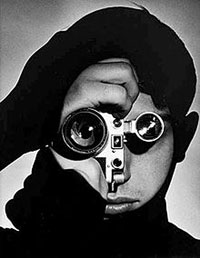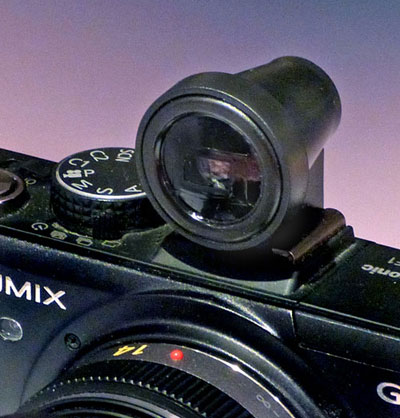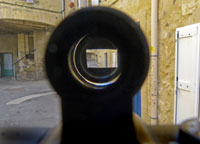Why Using an Optical Viewfinder with Your Camera Can Improve Your Photography
posted Monday, June 25, 2012 at 1:28 PM EST
 Growing up a rangefinder camera user, I have been using optical viewfinders (OVF) since an early age. They were, metaphorically speaking, my eyes. This is an idea powerfully visualized in Andreas Feininger’s portrait of recently deceased, Magnum photographer Dennis Stock. The portrait is shown to the right with Stock holding his Leica with optical viewfinder.
Growing up a rangefinder camera user, I have been using optical viewfinders (OVF) since an early age. They were, metaphorically speaking, my eyes. This is an idea powerfully visualized in Andreas Feininger’s portrait of recently deceased, Magnum photographer Dennis Stock. The portrait is shown to the right with Stock holding his Leica with optical viewfinder.
Today, although I shoot digital, I have still put OVFs in the hot shoes of my mirrorless cameras (at least the ones that have hot shoes).
This is not something crazy or done out of some weird nostalgia for a long gone film past. There are some very solid reasons why I use them and why I think that they can help other photographers.
Optical viewfinders have been around for a long time. Early 35mm cameras, like the Leica, had peephole viewfinders for 50mm lenses only.
They didn’t show the field of view of wider or longer lenses, and OFVs were made to help photographers frame with these other prime focal length lenses. Even after the arrival of the Leica M rangefinder with its multiple frame viewfinders, the accessory optical viewfinder remained popular, particularly with very wide-angle lenses.

OVFs can still play a role in today’s digital environment, for the following simple reasons:
· Shooting in bright sunlight and wearing sunglasses, I rely on an OVF because my camera’s LCD monitor is impossible to see.
· There is no distracting information—no information at all, in fact — displayed in the OVF, which makes it makes easier for me to see the whole frame and compose.
· With the camera taking care of focusing I can focus on the viewfinder.
· Using my OVF, I can turn off the monitor and prolong battery life.
· For street photography, or in any other rapidly changing situation, using an OVF is faster for me than using a monitor or EVF.
· Holding the camera up to my face to see the OVF is more a stable stance than having the camera at arm’s length to see the monitor.
Those were the the pros and now here are the cons to using an optical viewfinder.
· Framing is imprecise and parallax error is a problem particularly at distances of less than three or four feet.
· There is no playback of images.
· The accessory OVF slips into the hot shoe and can just as easily slip out, flying into the air and shattering on the pavement.
· OVFs are not cheap. An OVF made from Panasonic or Sony costs about $150; from Voigtlander over $200; and from Leica over $500. Since I need several for my different cameras and lenses, cost has been a big issue.
Therefore, I had been reluctant to get any until one day I discovered Boris Gorins and his plastic optical viewfinders.
Gorins is a Latvian born graphic designer who immigrated to Israel as a teenager. An avid photographer, he started making viewfinders by hand as a hobby. Today he sells several different focal length OVFs: 12, 15, 16, 18, 20, 21, 24, 25 and 28mm.
 Each fits snuggly into a hot shoe, but they do not connect at all to the camera. All plastic, these OVFs are practically indestructible, which for a bump prone photographer (me) is reassuring.
Each fits snuggly into a hot shoe, but they do not connect at all to the camera. All plastic, these OVFs are practically indestructible, which for a bump prone photographer (me) is reassuring.
These OVFs are very basic; just a little window showing the field of view. I say little because unlike a Leica or Voigtlander OVF, with a large image and bright frame-lines, these are small, almost like a rectangular 3:2 peephole. Gorins is very upfront and frank about all of this, however the price makes up for the limitations.
A Gorins OVF costs a mere $20.
That's right, just $20, which is the price of a 16GB memory card. Gorins adds to this a shipping charge that adds $11, but even so these OVFs are a steal.
They can be ordered directly from Gorins at this email address: [email protected]. You can check them out here. They can also be found eBay by searching for “viewfinder for Leica Voigtlander Zeiss Nikkor.”
Read his description of the viewfinders carefully. What you are getting for $20 is a workable OVF and not a gorgeous hunk of glass that sells for several hundred dollars. I’ve have a couple of Gorins plastic OVF and have used them a lot more than I expected. If you have a mirrorless camera and prime lenses, they are worth getting just to try out.
Moreover, using these OVFs not only remind me of my rangefinders, but I have noticed a pleasant change in my digital images. Compositionally, some are beginning to look like what I used to get with my film cameras.
While I do not completely understand what is happening, I have to admit that I like it a lot.